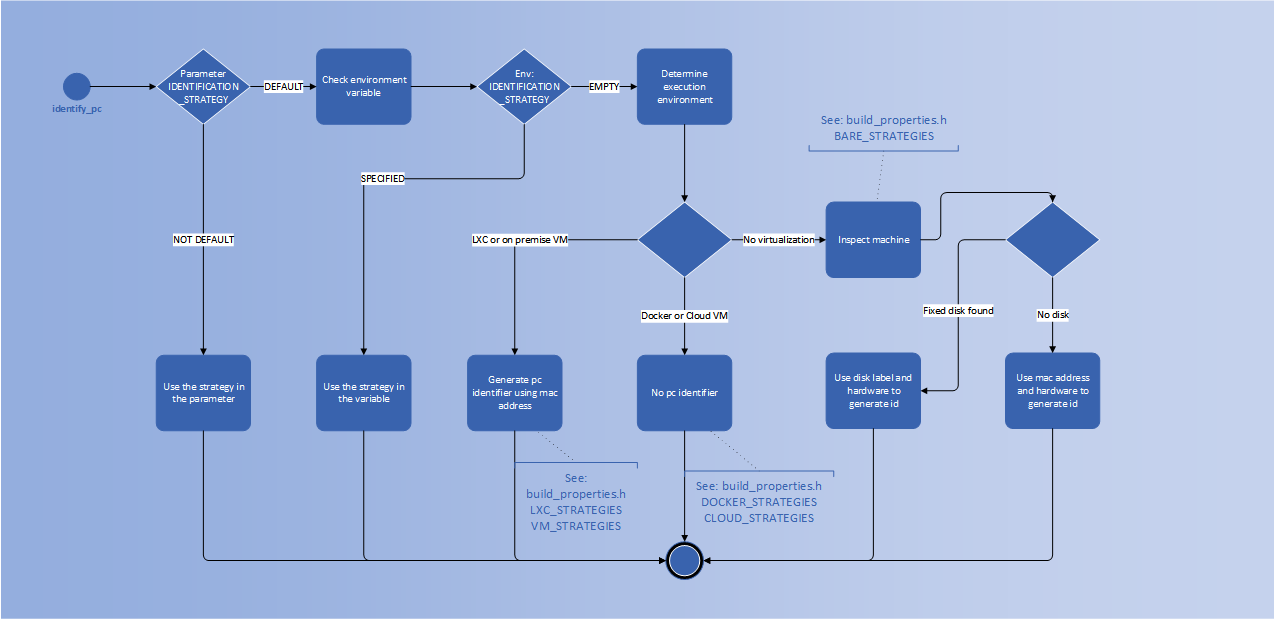Hardware Identifiers¶
Hardware identifiers are used to link the execution of the software to a physical hardware (a pc). The software executing on client’s hardware, when it finds the license is missing, calls the api identify_pc and generates an hardware identifier. The client has to communicate the hardware id back to the software publisher that will issue a license for him (for details see: issue licenses).
Note
Licensecc will guess the environment where the user is trying to launch the software (eg. a Virtual Machine), embed the information into the hardware id and report it to the software publisher before he is issuing the license.
Usage scenarios¶
With the recent coming of virtualized environments the installation of software directly on the machine has been less and less.
Execution in a physical hardware¶
If the client executes the software on a physical hardware it is possible to identify the hardware by various parameters (cpu type/memory/disk label/mac address) see features for detail of supported identification strageties.
Execution in a virtual machine¶
If you’re allowing software users to generate pc identifiers in a virtual machine you should ask yourself what’s the real use of it, since the vm can be copied as a whole elsewhere and there are few ways to detect this (without using an external license server that’s not yet supported by this library).
Usually when the machine is copied the MAC address is changed. But sometimes it changes on its own. Software publishers may want to use this as a last resort to prevent the vm for being cloned. It has to be verified case by case.
Software editors may want to prevent people from extracting the software from the VM. They can use an hidden registry key or a specific file in a location outside the installation directory to verify the software is distributed in the original VM. Or they can link the execution to a specific kind of virtualization (this is supported by OpenLicenseManager).
Tip
In this case issuing a demo license with just a date limitation is advised.
Execution in a container¶
Depending on how containers are used having hardware identifiers may make sense or no sense at all. For instance if containers are used to avoid to pollute the external distribution it makes perfect sense to have an hardware identifier, if users are running dockers in a kubernetes cluster in the cloud it makes no sense at all.
Hardware Identifier Generation¶
The licensed application will call the api method identify_pc to generate an hardware identifier and print it out to the user, the user then will contact the software licensor to get an appropriate license.
The licensed application can either decide an identification strategy by passing it in the identify_pc parameter hw_id_method
(see: LCC_API_HW_IDENTIFICATION_STRATEGY ) or let licensecc automatically choose how to generate the
identifier (by passing hw_id_method=STRATEGY_DEFAULT).
In this case licensecc is able to identify which virtual environment the user is running in and select the appropriate generation
strategy.
Below the full identifier generation workflow used by the identify_pc method.

Default identifier generation (implementation details)¶
This section describes the inner working of the default hardware identifer strategy.
When the licensed software calls identify_pc with LCC_API_HW_IDENTIFICATION_STRATEGY::STRATEGY_DEFAULT
the identifier generation will follow these steps:
It will first look to the environment variable
IDENTIFICATION_STRATEGY. If set it will use the identification strategy in that variable.
- It will try to determine which virtual environment the licensed software is running in.
If no virtual environment found it will use the strategies in
LCC_BARE_TO_METAL_STRATEGIES, it will try them one by one until the first one succeeds.If it detects it’s running in a Virtual Machine it will try the strategies in
LCC_VM_STRATEGIES, it will try them one by one until the first one succeeds.
- if you’re interested in implementing your own hardware identification strategy you can have a look to the library
Note
licensecc will try to validate the identifier using the same strategy that was used to generate it, regardless
of what is the default method now in use. eg: disk identifiers will always be validated by DiskStrategy.